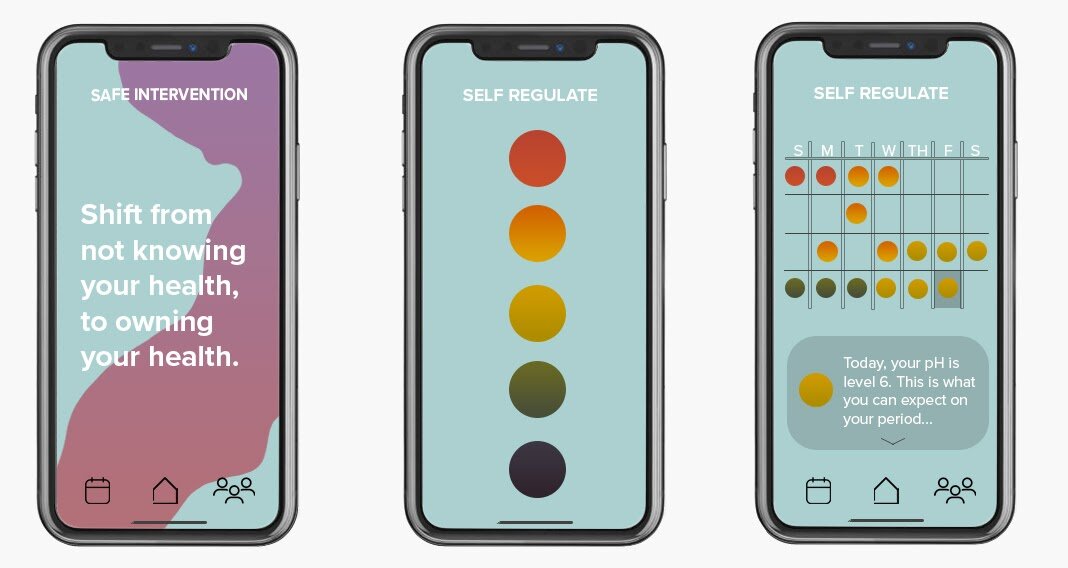The Blot Project
Menstrual Blood: An Informative Resource & Accelerator for Material Degeneration
Jasmine Brown // Heejung Chang // Ali Loftus // Sophia Yauck
A Socio-Environmental Project
The Blot Project is a socio-environmental project that aims to increase self-health engagement and reduce menstrual waste through a tri-fold approach: developing better materials from existing waste streams (1), engineering pH-activated materials to accelerate the schedule of material degeneration, and encouraging the self-monitoring of menstrual blood to detect common vaginal illnesses and diseases.
Waste Streams: Cranberry + Chitosan + Nettle
The existing waste streams of chitosan, cranberry [2], and nettle were chosen for their unique mechanical properties and links to menstrual health [3] to form three new materials: Chitocran, NettleCore, and Cran-hesive. Currently used in medical gauze and surgical application, chitosan is a hypoallergenic, antimicrobial material that, when in combination with the anti-adhesion tannins found in cranberries, form a strengthened, stabilized, pH-activated material that can detect irregularities that may indicate illnesses and diseases such as vaginosis, candidiasis, and trichomoniasis [4].
Programming Decay
In line with research conducted by the Wisconsin Alumni Research Foundation, tannin-chitosan composites have been found to increase degradation based on the ratio of materials [5]. In our scenario, the ratio of cranberry is used to strengthen the stability of the chitosan and increase the antimicrobial activity, by which the material’s degeneration can be engineered. Through the testing of materials with fluids of similar pH, we predict that the menstrual blood will serve as an acidic activator to speed the material degradation, thereby releasing biological nutrients into the biosphere and reducing the environmental impact of current [6], slow-to-degrade menstrual products.
Agency Over Health
What if materials could enable people with periods to have agency over their health? And what if those same material properties could enable us to program material decay? The waste streams of chitosan, cranberries and nettle are just the first step in reimagining our menstrual futures. The Blot Project’s materials, Chito-cran, NettleCore and Cran-hesive, advance sanitary products by leveraging waste as a resource and by empowering people with periods through educated self-monitoring.
If we can own our health, build with discoveries, and reduce waste streams, we can create for the future.
References
(1) Borunda, Alejandra. “How Tampons and Pads Became Unsustainable and Filled with Plastic.” Environment, National Geographic, 3 May 2021, www.nationalgeographic.com/environment/article/how-tampons-pads-became-unsustainable-story-of-plastic. (2)“Farmers Will Destroy One in Four Cranberries This Year.” The Counter, 20 Feb. 2020, thecounter.org/cranberry-glut-destroy-crop-volume-regulation-usda-ocean-spray/. (3) “Health Research.” Cranberry Institute, 30 Apr. 2019, www.cranberryinstitute.org/cranberry-health-research. (4) Hemalatha, R, et al. “Evaluation of Vaginal PH for Detection of Bacterial Vaginosis.” The Indian Journal of Medical Research, Medknow Publications & Media Pvt Ltd, Sept. 2013, www.ncbi.nlm.nih.gov/pmc/articles/PMC3818598/. (5) Dec 23, 2013 - Wisconsin Alumni Research Foundation. “Tannin-Chitosan Composites.” Justia, patents.justia.com/patent/9545423.(6) Shreya. “The Ecological Impact of Feminine Hygiene Products.” Technology and Operations Management, 4 Nov. 2016, digital.hbs.edu/platform-rctom/submission/the-ecological-impact-of-feminine-hygiene-products/. 






